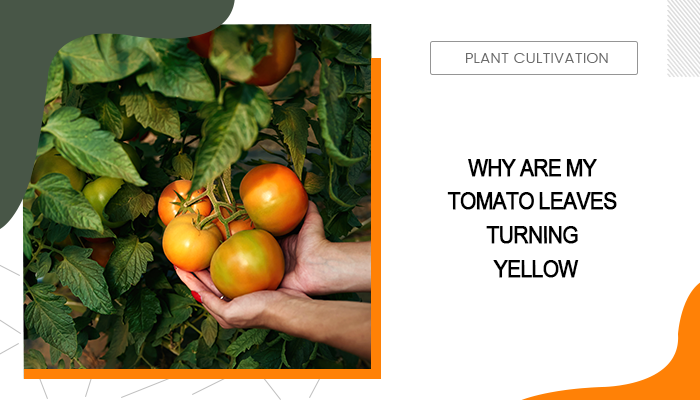Why Are My Tomato Leaves Turning Yellow & How to Fix
Prized for its delicious fruit and versatile uses, the tomato plant is a popular choice for house gardeners. However, one of the most common issues that tomato growers encounter is yellow leaves on tomato plants. Why are my tomato leaves turning yellow? This disconcerting sign can signal a variety of problems, some easily fixable and others more complex. No matter what the causes, we’ve got you covered in this post.
Table of Contents
Nutrient Deficiency
Tomato plants rely heavily on plenty of soil nutrient deficiencies to grow healthy foliage and yield tasty fruits, including Nitrogen, Potassium, Magnesium, Calcium, and Iron. Among them, the absence of adequate nitrogen is the top culprit for tomato leaf discoloration. Without nitrogen, the older leaves on the down parts typically start to turn yellow, as these leaves divert nutrients to younger, growing leaves.
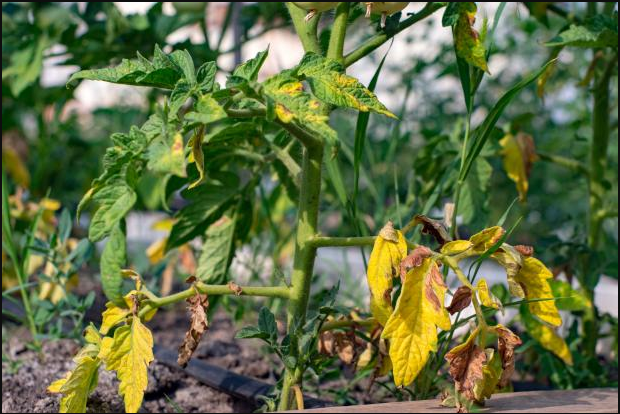
image source: Shutterstock/Mironmax Studio
Additionally, other nutrient deficiencies mentioned above can also cause yellowing leaves on tomatoes, but they do present slightly different characteristics on the leaves. Let’s find out how to distinguish them so you can better remedy the nutrient deficiency.
Potassium deficiency: As an essential nutrient needed for fruit quality and yield, lack of Potassium can cause the outer edges of leaves to go yellow, then turn brown and appear burned. Another symptom is the presence of yellow shoulders on the tomatoes, hampering the fruit’s ripening process.
Magnesium deficiency: Leaves turn yellow but veins remain green. You can also find spots or blotches on mature leaves on your tomato plant.
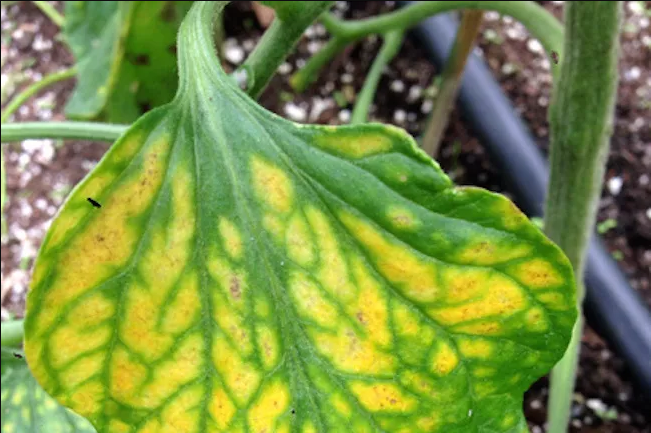
image source: SCOT NELSON/FLICKR
Calcium deficiency: Newer leaves on the tomato plant may turn yellow. Meanwhile, it may cause blossom end rot, where the bottom of fruits develops brown or black spots.
Iron deficiency: Newer leaves become yellow while retaining green veins. The leaves may appear pale green overall.
How to Fix Tomato Nutrient Deficiency
Before adding or getting rid of any fertilizer, doing soil testing is the most reliable method to understand what nutrients your soil needs, as it provides insights into soil composition, pH, and nutrient levels. Before adding or getting rid of any fertilizer, doing soil testing is the most reliable method to understand what nutrients your garden soil needs.
Once you figure out the situation, you can ask for recommendations on which fertilizers to use in local farm shops. You can also refer to the chart below for an average idea about which nutrient to add during the different growth stages of tomato plants.
|
Seedling Stage |
Vegetative Stage |
Flowering Stage |
|
|---|---|---|---|
|
Primary Nutrients |
A balanced mix of nitrogen (N), phosphorus (P), and potassium (K) |
Higher levels of nitrogen |
Lower levels of nitrogen but high levels of phosphorus and potassium |
|
Secondary Nutrients |
Calcium and magnesium |
Calcium and magnesium |
|
Tomato Diseases
Unfortunately, tomatoes are pretty vulnerable to a wide range of diseases, and some of them are the ones to blame for leaf discoloration. According to Tomato Diseases & Disorders by the University of Clemson’s College of Agriculture, Forestry, and Life Sciences, the following plant diseases are likely to cause yellowing of the tomato foliage.
Early Blight (Alternaria solani)
Late Blight (Phytophthora infestans)
Fusarium Wilt (Fusarium oxysporum)
Verticillium Wilt (Verticillium albo-atrum, Verticillium dahliae)
Septoria Leaf Spot (Septoria lycopersici)
Tomato Yellow Leaf Curl Virus
Tomato Spotted Wilt Virus
Mosaic Virus (Tobacco, Cucumber)
In severe cases, it may be necessary to remove the entire plant to prevent the spread of the disease.
How to Fix Tomato Diseases
Fortunately, although there’s a wide collection of viruses, the report above covers comprehensive guides for each case to help you recover yellowing leaves and solid tips to avoid these diseases.
Herbicide Drift Damage
When discussing the reasons for tomato leaves curling, we mentioned the damage brought by herbicide drift. Herbicide drift can damage plant roots, making it difficult for the tomato plant to absorb water and nutrients. Guess what? The herbicide drift is also responsible for tomato plants turning yellow. That’s because this fruit is naturally super sensitive to the chemicals in the herbicide, including Glyphosate, 2,4-D, Atrazine, etc. Even if it’s not your original target for grass-killing, the plant can easily get affected by the drifted herbicide.
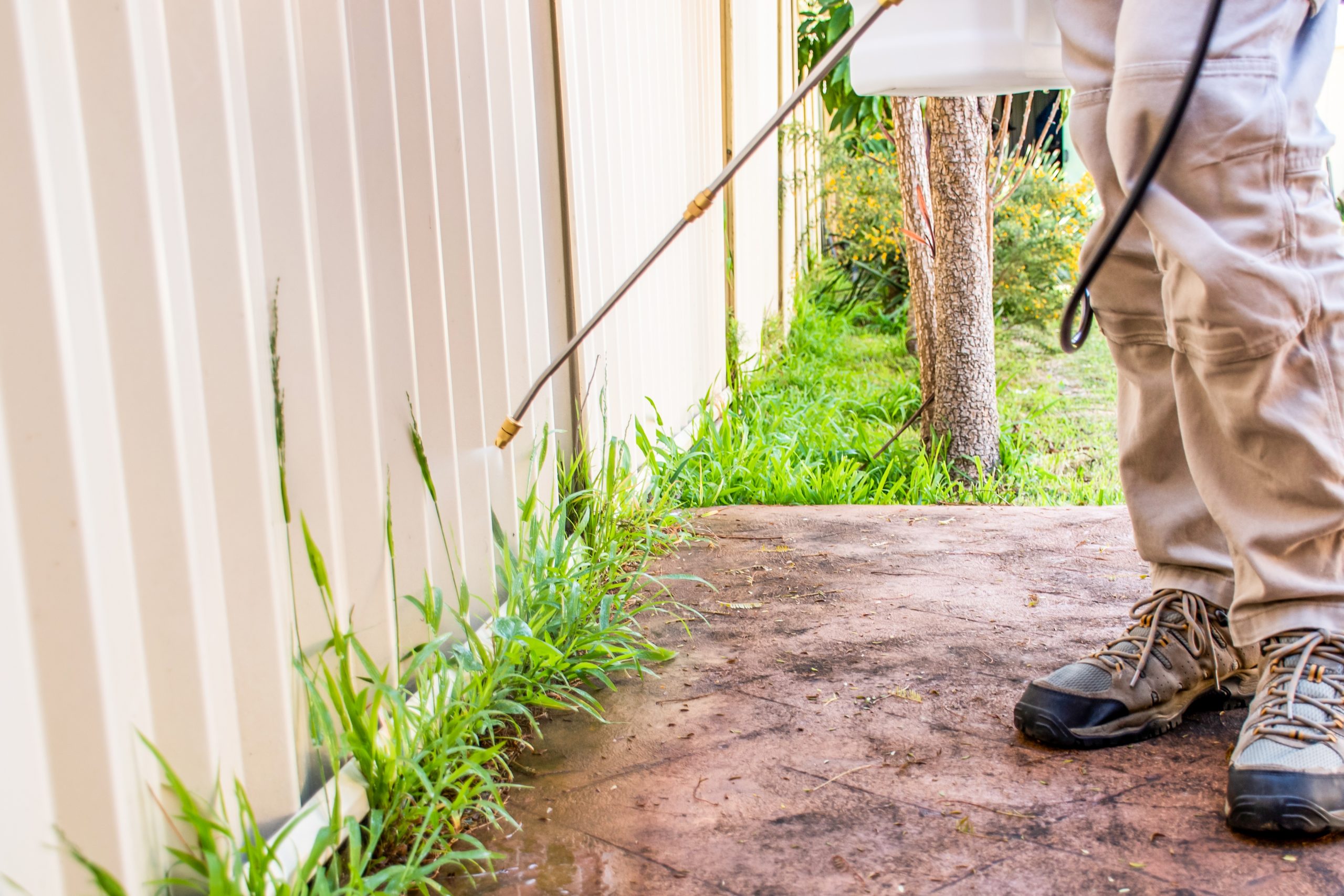
Can I Recover Yellow Leaves from Herbicide Drift
Truth speaking, it’s not likely to bring yellow leaves back to normal once damaged by the herbicide. You may notice a few yellow leaves as the plant begins to recover from herbicide damage. However, you can take action as soon as possible to stop the contamination and give a few weeks for new leaves. To further limit the grass, it’s suggested to opt for hand weeding and mulching as the replacement for herbicide.
Excessive Minerals
Tomatoes grown in pots and containers can easily accumulate too much salt and other minerals in the soil, especially when the water contains a heavy amount of salt. Maintaining proper nutrient levels is essential for healthy plants and can prevent issues like yellowing leaves. When that happens, it’s hard for tomatoes to absorb water and essential nutrients like nitrogen, phosphorus, and potassium from the soil, making tomato plants turn yellow.
How to Get Rid of Minerals Stuck in the Soil
- Flush the Soil
You can water the plant thoroughly, allowing water to run out of the bottom of the pot. This will help flush out excess salts. Make sure to discard the water that drains out to prevent reabsorption of the salts.
- Repotting
If the salt build-up is too severe to be flushed out, you might consider repotting the plant into fresh soil. Do remember to rinse the roots gently to remove as much of the old soil as possible.
- Check Your Water
It’s possible your water source is high in salts or minerals, especially if you are living in arid or coastal regions. For a situation like this, consider using filtered water to feed your plants.
Overwatering or Underwatering
Proper watering is the key to thriving tomato growth. Improper watering can exacerbate transplant shock, making it difficult for the plant to establish itself. Theoretically speaking, tomato plants need at least 1-2 inches of water per week to maintain vitality. The recommended metric can float up and down, depending on the actual soil moisture. When having too much water or too little water, tomato roots will find it hard to take up nutrients due to a lack of oxygen in the soil. Therefore, tomato leaves can get yellow and wilt with brown spots.
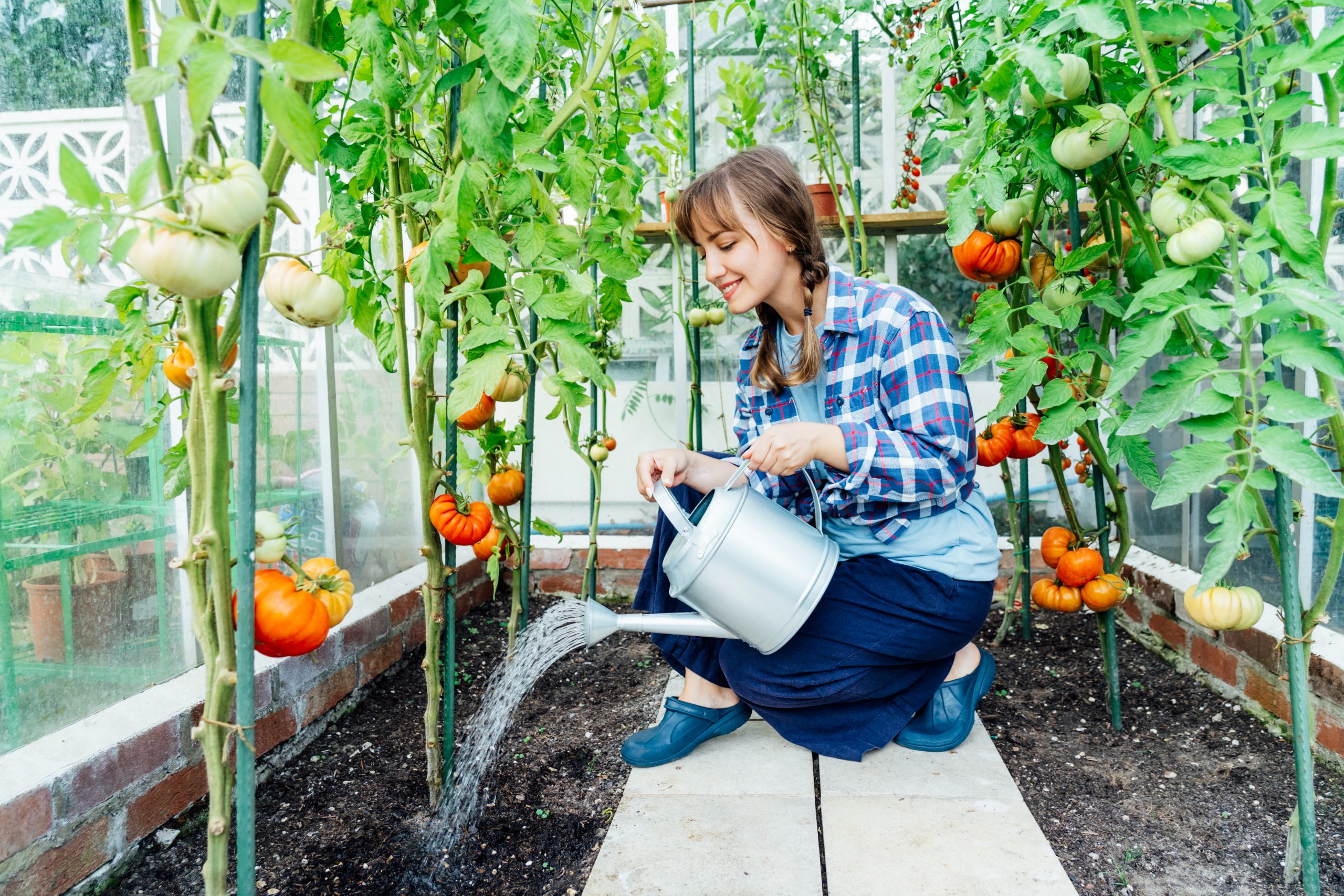
How to Fix Yellowing Tomato Leaves from Improper Watering
Before watering the plants, always sink your fingers into the soil to test the moisture level. If the soil is still wet deep down 2 inches, then it’s fine to give it a break without watering. On the contrary, once the soil feels dry, water the plants slowly and thoroughly to allow for a complete trickle into the soil.
Environmental Factors
Environmental factors play a significant role in the health and well-being of tomato plants. Temperature, humidity, wind, and sunlight exposure can all impact the color and texture of tomato leaves. For instance, high temperatures can cause tomato leaves to become scorched and turn yellow, while low temperatures can make them pale and wilted.
- Temperature: Tomato plants thrive in daytime temperatures between 65-70°F (18-21°C) and nighttime temperatures around 55-60°F (13-15°C). When temperatures soar above 85°F (29°C), heat stress can set in, leading to yellowing leaves.
- Humidity: These plants prefer a relatively high humidity level, typically above 50%. Low humidity can cause leaves to become dry and brittle, resulting in yellowing.
- Wind: Strong winds can physically damage tomato leaves, causing them to yellow and curl.
- Sunlight: Tomato plants require at least 6 hours of direct sunlight per day. However, intense sunlight can cause sunscald, leading to yellowing and blistering of leaves.
By monitoring and adjusting these environmental conditions, you can help prevent your tomato plants from turning yellow and ensure they remain healthy and productive.
Viral Infections
Viral infections can wreak havoc on tomato plants, causing a range of symptoms including yellowing leaves, stunted growth, and reduced fruit production. Some common viral infections that affect tomato plants include:
- Tomato Yellow Leaf Curl Virus (TYLCV): Transmitted by whiteflies, this virus causes yellowing and curling of leaves, severely affecting the plant’s health.
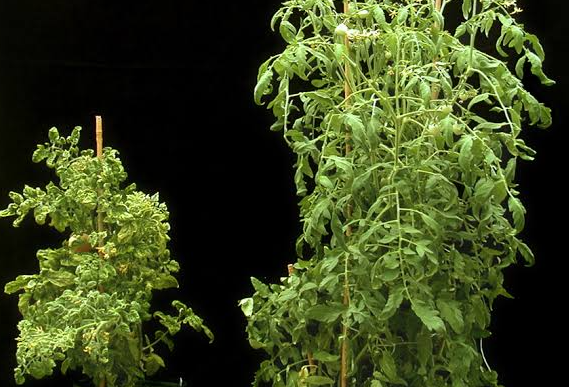
img source: blogs.ifas.ufl.edu
- Tomato Spotted Wilt Virus (TSWV): Spread by thrips, this virus leads to yellowing and stunting of plants, impacting their overall growth.
- Tobacco Mosaic Virus (TMV): Carried by aphids, this virus results in yellowing and mottling of leaves, compromising the plant’s vitality.
To manage viral infections in tomatoes, the following strategies might help:
- Use resistant varieties: Opt for tomato varieties that have built-in resistance to certain viral infections, say, Celebrity, Mountain Magic, Big Beef, etc.
- Practice good hygiene: Remove and dispose of infected plants, and disinfect tools and equipment to prevent the spread of viruses.
- Control vectors: Use insecticides or other methods to control whiteflies, thrips, and aphids that transmit these viruses.
- Use physical barriers: Employ row covers or other physical barriers to prevent vectors from reaching your plants.
By understanding the environmental factors that affect tomato plants and effectively managing viral infections, you can help keep your plants healthy and thriving, ensuring a bountiful harvest.
Conclusion
Why are my tomato leaves turning yellow? With a long list of causes explained above, including nutrient deficiencies, tomato dieases, herbicide damage, etc., you can diagnose the specific issue and implement the right solution. Remember, yellow leaves are the plant's way of sending a distress signal; heed it, and you can often reverse the issue before it severely affects your crop.
FAQs about Tomato Leaves Turning Yellow
- How do you fix yellow leaves on tomato plants?
To fix yellow leaves, you should first identify the cause, which could range from nutrient deficiencies to diseases. Depending on the issue, you may need to adjust watering, add specific nutrients, or treat specific diseases.
- Should you remove yellow leaves from tomato plants?
It depends on the cause. If the yellow leaves are diseased, removing them can prevent the spread to healthy leaves. However, if it's just a nutrient issue, fixing the nutrient imbalance would help recover yellow leaves from the plant.
- Does overwatering cause tomato leaves to turn yellow?
Yes, overwatering can cause leaves to turn yellow because it creates conditions that make it hard for the plant to absorb nutrients from the soil. Overwatering may also lead to root rot.
- What are the signs of overwatering tomato plants?
Signs of overwatering include yellow leaves, wilted appearance, and waterlogged soil. If the plant has puffy, swollen stems or leaves that look too full, it may also be a sign of overwatering.


